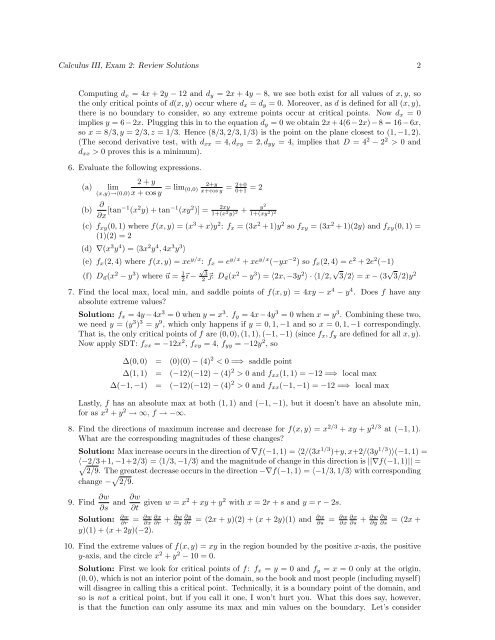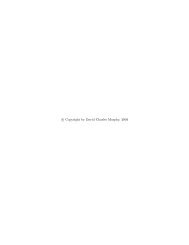1 Calculus III Exam 2 Practice Problems - Solutions
1 Calculus III Exam 2 Practice Problems - Solutions
1 Calculus III Exam 2 Practice Problems - Solutions
Create successful ePaper yourself
Turn your PDF publications into a flip-book with our unique Google optimized e-Paper software.
<strong>Calculus</strong> <strong>III</strong>, <strong>Exam</strong> 2: Review <strong>Solutions</strong> 2<br />
Computing d x = 4x + 2y − 12 and d y = 2x + 4y − 8, we see both exist for all values of x, y, so<br />
the only critical points of d(x, y) occur where d x = d y = 0. Moreover, as d is defined for all (x, y),<br />
there is no boundary to consider, so any extreme points occur at critical points. Now d x = 0<br />
implies y = 6 − 2x. Plugging this in to the equation d y = 0 we obtain 2x + 4(6 − 2x) − 8 = 16 − 6x,<br />
so x = 8/3, y = 2/3, z = 1/3. Hence (8/3, 2/3, 1/3) is the point on the plane closest to (1, −1, 2).<br />
(The second derivative test, with d xx = 4, d xy = 2, d yy = 4, implies that D = 4 2 − 2 2 > 0 and<br />
d xx > 0 proves this is a minimum).<br />
6. Evaluate the following expressions.<br />
(a)<br />
lim<br />
(x,y)→(0,0)<br />
2 + y<br />
x + cos y = lim 2+y<br />
(0,0) x+cos y = 2+0<br />
0+1 = 2<br />
∂<br />
(b)<br />
∂x [tan−1 (x 2 y) + tan −1 (xy 2 )] =<br />
2xy<br />
y<br />
1+(x 2 y)<br />
+<br />
2<br />
2 1+(xy 2 ) 2<br />
(c) f xy (0, 1) where f(x, y) = (x 3 + x)y 2 : f x = (3x 2 + 1)y 2 so f xy = (3x 2 + 1)(2y) and f xy (0, 1) =<br />
(1)(2) = 2<br />
(d) ∇(x 3 y 4 ) = 〈3x 2 y 4 , 4x 3 y 3 〉<br />
(e) f x (2, 4) where f(x, y) = xe y/x : f x = e y/x + xe y/x (−yx −2 ) so f x (2, 4) = e 2 + 2e 2 (−1)<br />
(f) D ⃗u (x 2 − y 3 ) where ⃗u = 1 2 ⃗ı − √ 3<br />
2 ⃗j: D ⃗u(x 2 − y 3 ) = 〈2x, −3y 2 〉 · 〈1/2, √ 3/2〉 = x − (3 √ 3/2)y 2<br />
7. Find the local max, local min, and saddle points of f(x, y) = 4xy − x 4 − y 4 . Does f have any<br />
absolute extreme values?<br />
Solution: f x = 4y −4x 3 = 0 when y = x 3 . f y = 4x−4y 3 = 0 when x = y 3 . Combining these two,<br />
we need y = (y 3 ) 3 = y 9 , which only happens if y = 0, 1, −1 and so x = 0, 1, −1 correspondingly.<br />
That is, the only critical points of f are (0, 0), (1, 1), (−1, −1) (since f x , f y are defined for all x, y).<br />
Now apply SDT: f xx = −12x 2 , f xy = 4, f yy = −12y 2 , so<br />
∆(0, 0) = (0)(0) − (4) 2 < 0 =⇒ saddle point<br />
∆(1, 1) = (−12)(−12) − (4) 2 > 0 and f xx (1, 1) = −12 =⇒ local max<br />
∆(−1, −1) = (−12)(−12) − (4) 2 > 0 and f xx (−1, −1) = −12 =⇒ local max<br />
Lastly, f has an absolute max at both (1, 1) and (−1, −1), but it doesn’t have an absolute min,<br />
for as x 2 + y 2 → ∞, f → −∞.<br />
8. Find the directions of maximum increase and decrease for f(x, y) = x 2/3 + xy + y 2/3 at (−1, 1).<br />
What are the corresponding magnitudes of these changes?<br />
Solution: Max increase occurs in the direction of ∇f(−1, 1) = 〈2/(3x 1/3 )+y, x+2/(3y 1/3 )〉(−1, 1) =<br />
〈−2/3+1, −1+2/3〉 = 〈1/3, −1/3〉 and the magnitude of change in this direction is ||∇f(−1, 1)|| =<br />
√<br />
2/9. The greatest decrease occurs in the direction −∇f(−1, 1) = 〈−1/3, 1/3〉 with corresponding<br />
change − √ 2/9.<br />
9. Find ∂w<br />
∂s<br />
and<br />
∂w<br />
∂t given w = x2 + xy + y 2 with x = 2r + s and y = r − 2s.<br />
∂w<br />
Solution:<br />
∂r<br />
= ∂w<br />
∂x<br />
y)(1) + (x + 2y)(−2).<br />
∂x<br />
∂r + ∂w<br />
∂y<br />
∂y<br />
∂r<br />
∂w<br />
= (2x + y)(2) + (x + 2y)(1) and<br />
∂s<br />
= ∂w ∂x<br />
∂x ∂s + ∂w ∂y<br />
∂y ∂s = (2x +<br />
10. Find the extreme values of f(x, y) = xy in the region bounded by the positive x-axis, the positive<br />
y-axis, and the circle x 2 + y 2 − 10 = 0.<br />
Solution: First we look for critical points of f: f x = y = 0 and f y = x = 0 only at the origin,<br />
(0, 0), which is not an interior point of the domain, so the book and most people (including myself)<br />
will disagree in calling this a critical point. Technically, it is a boundary point of the domain, and<br />
so is not a critical point, but if you call it one, I won’t hurt you. What this does say, however,<br />
is that the function can only assume its max and min values on the boundary. Let’s consider
















